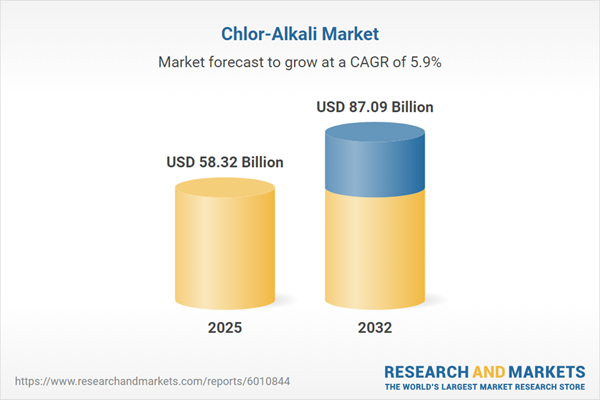Speak directly to the analyst to clarify any post sales queries you may have.
The chlor-alkali market serves as a cornerstone for critical industrial supply chains, supporting sectors ranging from chemical production to water treatment. Senior leaders must understand evolving market forces, innovative technologies, and policy shifts shaping the competitive landscape to drive efficient and sustainable growth.
Market Snapshot: Size and Projected Growth in the Chlor-Alkali Market
The global chlor-alkali market grew from USD 55.22 billion in 2024 to USD 58.32 billion in 2025 and is forecast to reach USD 87.09 billion by 2032, expanding at a CAGR of 5.86%. This sustained rise reflects robust downstream demand, particularly for caustic soda, chlorine, and soda ash, against a backdrop of persistent cost, regulatory, and supply chain pressures. Key drivers include process optimization, investment in lower-emission technologies, and agile responses to shifting policy environments.
Scope & Segmentation of the Global Chlor-Alkali Market
- Product Type: Caustic Soda, Chlorine, Soda Ash
- Production Method: Diaphragm Cell Method, Membrane Cell Method, Mercury Cell Method
- Application: Drug Manufacturing, Glass Manufacturing, Organic & Inorganic Chemicals, Pulp & Paper Processing, Soap & Detergents, Textile Processing, Water Treatment
- Regional Coverage: Americas (United States, Canada, Mexico, Brazil, Argentina, Chile, Colombia, Peru), Europe (United Kingdom, Germany, France, Russia, Italy, Spain, Netherlands, Sweden, Poland, Switzerland), Middle East (United Arab Emirates, Saudi Arabia, Qatar, Turkey, Israel), Africa (South Africa, Nigeria, Egypt, Kenya), Asia-Pacific (China, India, Japan, Australia, South Korea, Indonesia, Thailand, Malaysia, Singapore, Taiwan)
- Key Industry Players: Aditya Birla Group, AGC Inc., Akzo Nobel N.V., Bodal Chemicals Limited, BorsodChem Zrt, Covestro AG, Dow Chemical Company, Ercros S.A, Formosa Plastics Corporation, Genesis Energy, L.P., Hanwha Group, INEOS AG, KEM ONE SAS, Kemira Oyj's, MicroBio, Nirma Limited, Nouryon Chemicals Holding B.V., Occidental Petroleum Corporation, Olin Corporation, Solvay S.A., Tata Chemicals Limited, Tosoh Bioscience, Inc., Vynova Group, Westlake Corporation, Xinjiang Zhongtai Chemical Co., Ltd.
Key Takeaways for Senior Decision-Makers
- The chlor-alkali industry increasingly prioritizes energy efficiency and environmental compliance, prompting transition to membrane and diaphragm cell technologies and away from mercury-based processes.
- Producers are leveraging digital tools for process control, predictive maintenance, and analytics to improve operational reliability, safety, and proactive asset management.
- Supply chain agility has become vital as geopolitical dynamics, such as regional tariff interventions, shift commodity flows and require flexible logistics and procurement strategies.
- Adoption of circular economy principles, including brine recycling and byproduct recovery, allows producers to reduce waste and unlock value streams in line with sustainability objectives.
- Regional growth depends on infrastructure readiness, regulatory frameworks, and access to cost-efficient feedstocks, influencing both expansion strategies and investment priorities across markets.
Tariff Impact and Evolving Competitive Dynamics
Recent tariff measures in the United States have increased input costs for soda ash and caustic soda, pushing domestic producers to reevaluate sourcing and pricing strategies. International trade flows have subsequently adapted, with suppliers seeking alternative markets and renegotiating contracts. Companies are adopting mitigation tactics, including vertical integration, inventory buffering, and partnerships, to sustain operational and financial resilience in the face of policy-driven disruptions.
Methodology & Data Sources
This report is based on primary interviews with senior industry executives and technical experts, supported by site visits, and an extensive review of second-tier sources such as industry journals, regulatory filings, and financial disclosures. Quantitative models and scenario analyses evaluate technology adoption and tariff outcomes, ensuring robust findings and actionable conclusions.
Why This Report Matters for Executive Leadership
- Enables evidence-based strategic planning by dissecting market drivers, technological innovation, and regulatory trends in the chlor-alkali sector.
- Supports investment and expansion decisions through detailed segmentation, regional analysis, and insight into leading company strategies.
- Provides a framework for enhancing resilience and sustainability under evolving trade, policy, and environmental conditions.
Conclusion
The chlor-alkali market is evolving as technological, regulatory, and policy forces create new opportunities and challenges. Strategic agility, investment in process innovation, and proactive sustainability initiatives remain crucial for market leadership and long-term growth.
Additional Product Information:
- Purchase of this report includes 1 year online access with quarterly updates.
- This report can be updated on request. Please contact our Customer Experience team using the Ask a Question widget on our website.
Table of Contents
3. Executive Summary
4. Market Overview
7. Cumulative Impact of Artificial Intelligence 2025
Companies Mentioned
The companies profiled in this Chlor-Alkali market report include:- Aditya Birla Group.
- AGC Inc.
- Akzo Nobel N.V.
- Bodal chemicals limited
- BorsodChem Zrt
- Covestro AG
- Dow Chemical Company
- Ercros S.A
- Formosa Plastics Corporation
- Genesis Energy, L.P.
- Hanwha Group
- INEOS AG
- KEM ONE SAS
- Kemira Oyj’s
- MicroBio
- Nirma Limited
- Nouryon Chemicals Holding B.V.
- Occidental Petroleum Corporation
- Olin Corporation
- Solvay S.A.
- Tata Chemicals Limited
- Tosoh Bioscience, Inc.
- Vynova Group
- Westlake Corporation
- Xinjiang Zhongtai Chemical Co., Ltd.
Table Information
| Report Attribute | Details |
|---|---|
| No. of Pages | 196 |
| Published | November 2025 |
| Forecast Period | 2025 - 2032 |
| Estimated Market Value ( USD | $ 58.32 Billion |
| Forecasted Market Value ( USD | $ 87.09 Billion |
| Compound Annual Growth Rate | 5.8% |
| Regions Covered | Global |
| No. of Companies Mentioned | 26 |









